初中英语阅读课操作流程
初中教案英语阅读
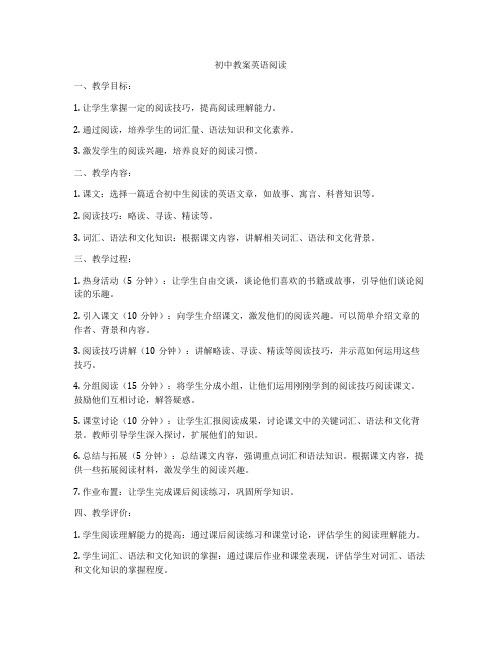
初中教案英语阅读一、教学目标:1. 让学生掌握一定的阅读技巧,提高阅读理解能力。
2. 通过阅读,培养学生的词汇量、语法知识和文化素养。
3. 激发学生的阅读兴趣,培养良好的阅读习惯。
二、教学内容:1. 课文:选择一篇适合初中生阅读的英语文章,如故事、寓言、科普知识等。
2. 阅读技巧:略读、寻读、精读等。
3. 词汇、语法和文化知识:根据课文内容,讲解相关词汇、语法和文化背景。
三、教学过程:1. 热身活动(5分钟):让学生自由交谈,谈论他们喜欢的书籍或故事,引导他们谈论阅读的乐趣。
2. 引入课文(10分钟):向学生介绍课文,激发他们的阅读兴趣。
可以简单介绍文章的作者、背景和内容。
3. 阅读技巧讲解(10分钟):讲解略读、寻读、精读等阅读技巧,并示范如何运用这些技巧。
4. 分组阅读(15分钟):将学生分成小组,让他们运用刚刚学到的阅读技巧阅读课文。
鼓励他们互相讨论,解答疑惑。
5. 课堂讨论(10分钟):让学生汇报阅读成果,讨论课文中的关键词汇、语法和文化背景。
教师引导学生深入探讨,扩展他们的知识。
6. 总结与拓展(5分钟):总结课文内容,强调重点词汇和语法知识。
根据课文内容,提供一些拓展阅读材料,激发学生的阅读兴趣。
7. 作业布置:让学生完成课后阅读练习,巩固所学知识。
四、教学评价:1. 学生阅读理解能力的提高:通过课后阅读练习和课堂讨论,评估学生的阅读理解能力。
2. 学生词汇、语法和文化知识的掌握:通过课后作业和课堂表现,评估学生对词汇、语法和文化知识的掌握程度。
3. 学生阅读兴趣和习惯的培养:观察学生在课堂上的积极参与程度和课后阅读的习惯,评估他们的阅读兴趣和习惯是否得到培养。
五、教学资源:1. 课文:选择适合初中生阅读的英语文章。
2. 阅读技巧指导:相关阅读技巧的资料和示例。
3. 词汇、语法和文化知识讲解:相关词汇、语法和文化背景的资料。
4. 课后阅读练习:相关阅读练习题。
六、教学建议:1. 注重培养学生的阅读兴趣,激发他们的阅读动力。
初中英语阅读课授课流程图
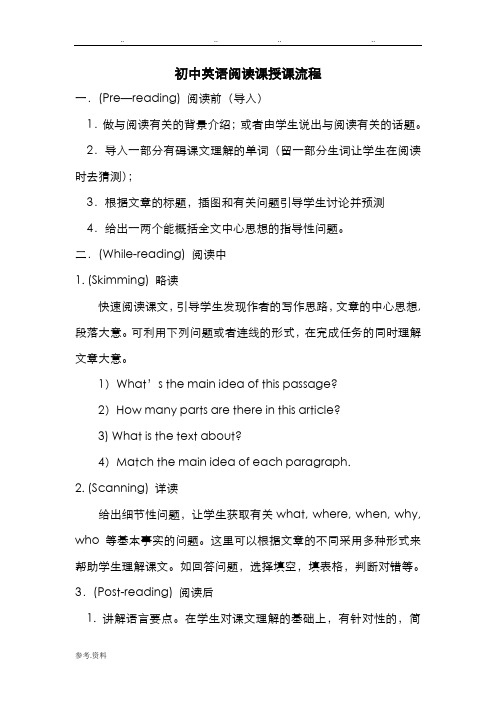
初中英语阅读课授课流程一.(Pre—reading) 阅读前(导入)1.做与阅读有关的背景介绍;或者由学生说出与阅读有关的话题。
2.导入一部分有碍课文理解的单词(留一部分生词让学生在阅读时去猜测);3.根据文章的标题,插图和有关问题引导学生讨论并预测4.给出一两个能概括全文中心思想的指导性问题。
二.(While-reading) 阅读中1. (Skimming) 略读快速阅读课文,引导学生发现作者的写作思路,文章的中心思想,段落大意。
可利用下列问题或者连线的形式,在完成任务的同时理解文章大意。
1)What’s the main idea of this passage?2)How many parts are there in this article?3) What is the text about?4)Match the main idea of each paragraph.2. (Scanning) 详读给出细节性问题,让学生获取有关what, where, when, why, who等基本事实的问题。
这里可以根据文章的不同采用多种形式来帮助学生理解课文。
如回答问题,选择填空,填表格,判断对错等。
3.(Post-reading) 阅读后1. 讲解语言要点。
在学生对课文理解的基础上,有针对性的,简明扼要的分析、解释新语言现象。
同时,检查学生对生词的猜测情况;(知识点点到为止,不要拓展,不要联想)2. 做语言知识练习。
但需要注意的是,非课标要求的项目不以做过多的练习。
(以上两步不要超过10分钟)3. 语言运用。
围绕课文展开各种形式的口,笔头交际活动,如复述课文,问题讨论,角色扮演,采访,调查,仿效与课文有关的话题等。
初中英语阅读课操作流程上课讲义

初中英语阅读课教学流程与教学课例会昌实验学校王久荣一、教学流程与操作要求(一)、预习检查课前下发预习任务,主要是翻译词组与句子。
其中不包括全部生词,让学生在阅读过程中还有猜测环节。
(二)、课前热身设计与阅读内容相关的情境性活动,注意生词的复现,从而巩固生词。
主要采取小组活动,这样既巩固了词汇,同时也为阅读做了铺垫。
(三)、任务阅读1、读前活动(Pre-reading activities)学生可根据标题或课本中的插图猜测课文内容;教师可根据阅读材料设计判断正误题(T\F),让学生先判断再速读课文检查。
2、阅读活动(While- reading activities)(1)、速读(Fast reading)教师设计简单的任务。
如What’s t he article about? Who is Lucky? 或提供每段的小标题,让学生通过选择的形式放在正确的段落。
还可设计简单的T\F问题。
引导学生通过跳读(获取特定信息的阅读)快速完成任务,从而整体理解文章大意。
(2)、细读(Careful reading)任务设计:回答问题、选择题、填表、T\F问题等;文字字面理解任务。
包括学生找出重点词组句子,讨论理解。
对于难以理解的知识点在导学案中体现。
如:Being blind, deaf, unable to walk, or use your hands easily is something t hat most people cannot imagine. 此句中“being…”是动名词做主语。
谓语动词用单数。
“…that most people cannot imagine”是定语从句,修饰something。
3、课后活动(Post reading activities)(1)、对文章观点及问题的讨论、复述、分角色表演,完成所写文章等。
(2)、学生的总结(小组合作):学习所得,语言知识等。
(3)、拓展阅读:老师可选择一篇或几篇相关内容的文章,设计任务,学生带任务阅读。
初中英语阅读课教案

初中英语阅读课教案课程目标:1. 学生能够理解并运用阅读材料中的关键信息和词汇。
2. 学生能够提高阅读理解能力,培养良好的阅读习惯。
3. 学生能够通过阅读,培养对英语学习的兴趣和积极性。
教学内容:1. 阅读材料:一篇关于动物的英文短文。
2. 关键词汇:动物名称、特征、生活习性等。
教学步骤:Step 1: 导入(5分钟)1. 教师与学生进行简单的英语交流,询问学生对动物的了解和喜好。
2. 教师引导学生谈论一些常见的动物,如猫、狗、鸟等,并简要介绍这些动物的特征和习性。
Step 2: 阅读材料展示(10分钟)1. 教师向学生展示阅读材料,让学生阅读并理解文章内容。
2. 教师引导学生关注文章中的关键词汇,如动物名称、特征、生活习性等。
Step 3: 阅读理解练习(15分钟)1. 教师设计一些阅读理解题目,让学生根据文章内容进行回答。
2. 教师鼓励学生积极参与,引导他们通过阅读材料来寻找答案。
Step 4: 小组讨论(10分钟)1. 教师将学生分成小组,让学生相互分享自己的阅读理解和观点。
2. 教师引导学生通过讨论来深入理解文章内容,并培养他们的团队合作能力。
Step 5: 总结与反馈(5分钟)1. 教师对学生的阅读理解和讨论进行总结和评价。
2. 教师鼓励学生提出问题,解答学生的疑惑。
教学评价:1. 学生阅读理解题目的答题情况。
2. 学生在小组讨论中的参与度和合作能力。
3. 学生对阅读材料的兴趣和积极性。
教学反思:本节课通过阅读一篇关于动物的英文短文,旨在提高学生的阅读理解能力和培养良好的阅读习惯。
在教学过程中,教师应注重引导学生关注文章中的关键词汇,并通过阅读理解题目来检验学生的理解程度。
同时,小组讨论环节可以培养学生的团队合作能力和交流表达能力。
在教学评价中,教师应关注学生的答题情况、参与度和兴趣,以便更好地指导学生提高英语阅读能力。
初中英语阅读课步骤
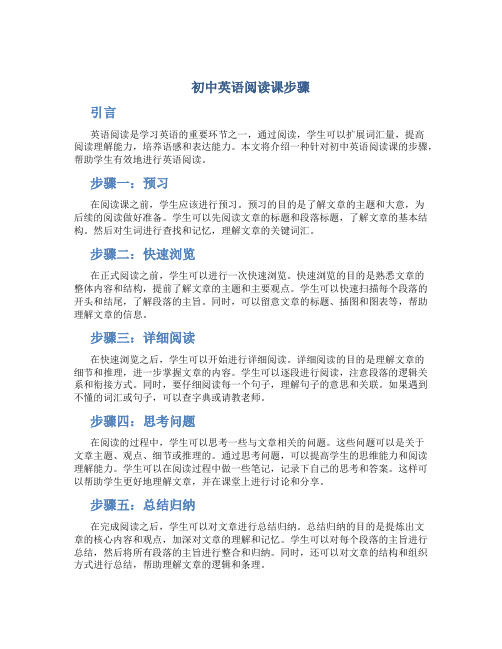
初中英语阅读课步骤引言英语阅读是学习英语的重要环节之一,通过阅读,学生可以扩展词汇量,提高阅读理解能力,培养语感和表达能力。
本文将介绍一种针对初中英语阅读课的步骤,帮助学生有效地进行英语阅读。
步骤一:预习在阅读课之前,学生应该进行预习。
预习的目的是了解文章的主题和大意,为后续的阅读做好准备。
学生可以先阅读文章的标题和段落标题,了解文章的基本结构。
然后对生词进行查找和记忆,理解文章的关键词汇。
步骤二:快速浏览在正式阅读之前,学生可以进行一次快速浏览。
快速浏览的目的是熟悉文章的整体内容和结构,提前了解文章的主题和主要观点。
学生可以快速扫描每个段落的开头和结尾,了解段落的主旨。
同时,可以留意文章的标题、插图和图表等,帮助理解文章的信息。
步骤三:详细阅读在快速浏览之后,学生可以开始进行详细阅读。
详细阅读的目的是理解文章的细节和推理,进一步掌握文章的内容。
学生可以逐段进行阅读,注意段落的逻辑关系和衔接方式。
同时,要仔细阅读每一个句子,理解句子的意思和关联。
如果遇到不懂的词汇或句子,可以查字典或请教老师。
步骤四:思考问题在阅读的过程中,学生可以思考一些与文章相关的问题。
这些问题可以是关于文章主题、观点、细节或推理的。
通过思考问题,可以提高学生的思维能力和阅读理解能力。
学生可以在阅读过程中做一些笔记,记录下自己的思考和答案。
这样可以帮助学生更好地理解文章,并在课堂上进行讨论和分享。
步骤五:总结归纳在完成阅读之后,学生可以对文章进行总结归纳。
总结归纳的目的是提炼出文章的核心内容和观点,加深对文章的理解和记忆。
学生可以对每个段落的主旨进行总结,然后将所有段落的主旨进行整合和归纳。
同时,还可以对文章的结构和组织方式进行总结,帮助理解文章的逻辑和条理。
结论初中英语阅读课的步骤对于学生的英语学习有着重要的意义。
通过预习、快速浏览、详细阅读、思考问题和总结归纳,学生可以更好地理解和掌握英语文章的内容。
同时,这些步骤也培养了学生的阅读能力和思维能力,为学生今后的英语学习打下了坚实的基础。
初中英语阅读课教案(热门5篇)
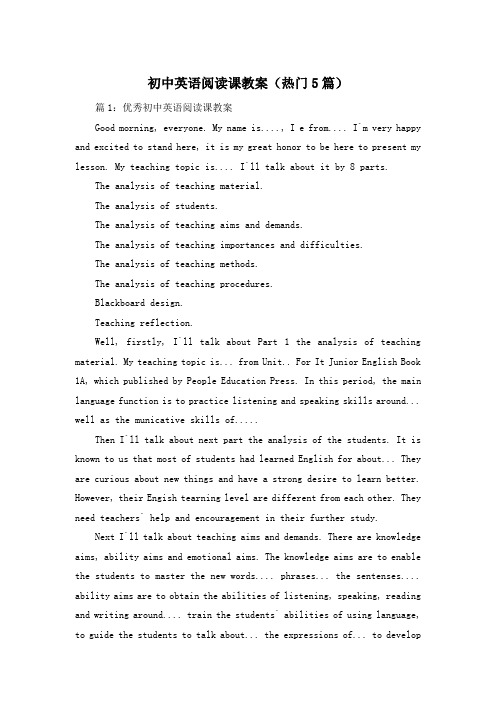
初中英语阅读课教案(热门5篇)篇1:优秀初中英语阅读课教案Good morning, everyone. My name is...., I e from.... I`m very happy and excited to stand here, it is my great honor to be here to present my lesson. My teaching topic is.... I`ll talk about it by 8 parts.The analysis of teaching material.The analysis of students.The analysis of teaching aims and demands.The analysis of teaching importances and difficulties.The analysis of teaching methods.The analysis of teaching procedures.Blackboard design.Teaching reflection.Well, firstly, I`ll talk about Part 1 the analysis of teaching material. My teaching topic is... from Unit.. For It Junior English Book 1A, which published by People Education Press. In this period, the main language function is to practice listening and speaking skills around... well as the municative skills of.....Then I`ll talk about next part the analysis of the students. It is known to us that most of students had learned English for about... They are curious about new things and have a strong desire to learn better. However, their Engish tearning level are different from each other. They need teachers` help and encouragement in their further study.Next I`ll talk about teaching aims and demands. There are knowledge aims, ability aims and emotional aims. The knowledge aims are to enable the students to master the new words.... phrases... the sentenses.... ability aims are to obtain the abilities of listening, speaking, reading and writing around.... train the students` abilities of using language, to guide the students to talk about... the expressions of... to developthe students` ability of creative thinking and cooperative study. The emotional aims are to enable.....Let`s move on to another part: the analysis of teaching importances and difficulties. The teaching importances are... teaching difficulties are.....Next is teaching methods. I use.. in my lesson. There are multimedia puter assisted instruction, task-based activities, situational approach, total physical response or the audio-lingual method.Now I`ll talk about teaching procedures. According to five steps teaching method, I design my lesson into five steps.Step 1 is warm-up. Here I`ll... this, the students can be interested in it and pay their attention to our class easily and....Step 2 is lead-in. Here I`ll... this, the students.....Step 3 is presentation. Here I`ll.... this, the students...... Step 4 is practice. Here I`ll... this, the students......Step 5 is homework. Here I`ll..... this ,the students.....Next is my blackboard design. I`ll design it like this.....At last, I want to say, to be a good teacher is my dream. I think a teacher is not only a guide for sudents, but also a friend of them. If I were a teacher, I would build a close relation with my students, helping them not only on their study but also on their lives. I`ll try my best, and I have confident that I can do it.Ok, that`s all. Thanks for your listening. Good-bye.篇2:优秀初中英语阅读课教案Unit 10 Where did you go on vacation?Good morning, everyone. I am from the . I have taught English for over ten years and I like my students. Today, I will talk about Unit 10 where did you go on vacation? Go for it Junior English Book are 6 periodsto finish this unit. I will talk about the first period with the following parts..I. Analysis of the Teaching Materials.The topic of this unit is the continuation of unit 9 as well as about the past events.By using the Simple PasT Tense,which is essential in junior English,students willtalk about their topic is about their experiences and places they havevisited on their it helps bring back their memories and learning motivations.II. Students’ characteristicAlthough the Junior 1 has been learning English for almost a year and are havingsome basic knowledge. Because of living in China and surrounding environment, students are learning English impassively and irregularly. But The junior 1 has showned themselves very creative,capable and of plasticity as they’re doing so well in what they’re interested in such as games and CAI.Aims and Demandsobjectivesa. To enable the students to read, to spell , to understand the vocabulary correctly.b. To help the students ask and answer the new sentence pattern: Where did you go on vacation?objectives.a. To improve the students’ skills of listening ,speaking,reading and writing..b. To encourage the students to municate with others uning the newsentence pattern .objectivesa. To train the Ss to cooperate well in groups and in pairs.b. To be interested in municating in English.IV. Teaching Key Points1. Key vocabularyNew York City camp summer camp museum2. Key structuresWhere did you go on vacation?I went to…V. Teaching DifficultyLearn the key structuresVI. Teaching Methods1. Task-based methodThat’s to say I’ll let the students finish 1 listening task and make short dialogues along with the actions to help the students get a better understanding of the keystructures.2. munication methodI’ll set up a dream and ask students to pretent themse lves as reporters. This way, the students can say freely and needn’t to worry about making mistakes.VII. Learning Methods1. Listening—speaking method2. municative strategyWe all know that the best ways to learn English well are to imitate,to practice,to listen,to speak and to municate more constantly.VIII. Teaching AidsIn this lesson, the CAI, cassette, a tape recorder will be used.X. Teaching ProcedureI’ll mainly talk about this part. It consists of 5 steps.Step 1 Warm – up and review1. Make a free talk between T-S. What did you do yesterday? And what did your best friend do yesterday?2. Write down the past tenses of the verbs that I show in CAI.Purpose: this step is in order to review what the students have learnt in Unit way, I can lead them into the new lesson smoothly. I think It’s usual but pratical.Step 2 Presentation1. Learn the new words and expressionsa. lead—in: ask students some questions: Did you dream last night? What did you dream? Where did I go on vacation in my dream?b. CAI shows many pictures of my dream,which are also the activities in 1a .c. Ask students to read and spell the new phrases.d. Do 1a. Match the activities with the pictures (a—g).e. Play a guessing game: I will show some jigsaws of each picture and have the students to guess. I will praise the student who answers more quickly.Purpose: I put the vocabulary learning into a dream in order to prompt them to find it very interesting to learn English.. By CAI, students can match the vocabulary with the real things directly and master them easily. Step 3 Listening practicea. Tell the students to listen to the tape and number the people (1—5) in the picture.b. Play the recorder for the first time, and then check the answers.c. Play the recorder again, students imitate the conversations and fill in the blanks. Pay attention to their pronunciation and intonation.Purpose: this is a basic and necessary step, which develops the students’ skills of listening, reading and writing.Step 4 Pairworka. T—S: where did Tina go on vacation?She went to the mountains.b. Ask the students to practice in pairs as we 1c. Then they will e to the platform and click on the number to choose a picture and act it out randomlyPurpose: “Task-based”teaching method is used here to develop the students’ability ofmunication and their ability of co-operation will be well trained. This step provides guided oral practice using the target language to consolidate the key structure and It can develop students’ skill of speaking and sense of language.Step5 ProductionHave students pretent to be reporters to interview anyone they want to ask about their vacation.Purpose: After learning 1a—1c, it’s time to extend what they learnt just now and give the students a free space to show their abilities. With the real situations, students will feel easy and successful during this part. By way of munication, the students will understand how to use the key structure better and consolidate the knowledge firmly.Part XI HomeworkDo a survey and write a report about the classmates’ vocation. Purpose: I think homework is so important that the students can speak english as much as they can in class or after set this step in order to practice students’ skills of listening, speaking and writing.Blackboard Design篇3:优秀初中英语阅读课教案教学目标教学目标Aim 记忆物品pants , socks , T-shirt , shirt , shorts , sweater , shoes理解颜色理解:color , black , white , red , green , blue ,应用通过布置任务,让学生在合作中进行语言交流。
初中英语阅读教案步骤设计
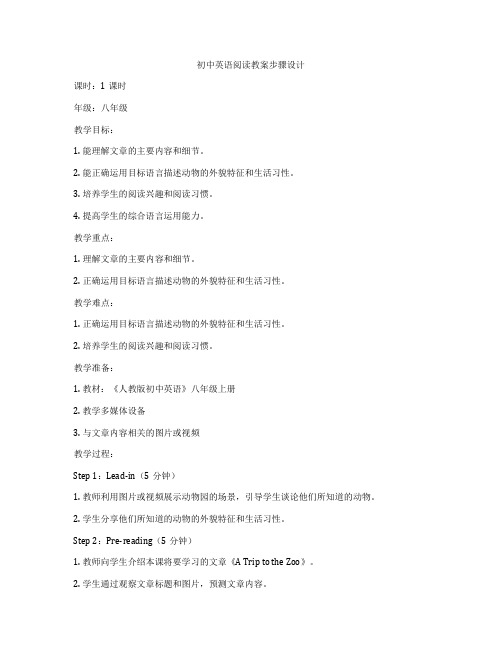
初中英语阅读教案步骤设计课时:1课时年级:八年级教学目标:1. 能理解文章的主要内容和细节。
2. 能正确运用目标语言描述动物的外貌特征和生活习性。
3. 培养学生的阅读兴趣和阅读习惯。
4. 提高学生的综合语言运用能力。
教学重点:1. 理解文章的主要内容和细节。
2. 正确运用目标语言描述动物的外貌特征和生活习性。
教学难点:1. 正确运用目标语言描述动物的外貌特征和生活习性。
2. 培养学生的阅读兴趣和阅读习惯。
教学准备:1. 教材:《人教版初中英语》八年级上册2. 教学多媒体设备3. 与文章内容相关的图片或视频教学过程:Step 1:Lead-in(5分钟)1. 教师利用图片或视频展示动物园的场景,引导学生谈论他们所知道的动物。
2. 学生分享他们所知道的动物的外貌特征和生活习性。
Step 2:Pre-reading(5分钟)1. 教师向学生介绍本课将要学习的文章《A Trip to the Zoo》。
2. 学生通过观察文章标题和图片,预测文章内容。
Step 3:While-reading(15分钟)1. 学生快速阅读文章,回答以下问题:a. Who is the writer?b. Where does the writer go?c. What animals does the writer see at the zoo?d. What are the characteristics and habits of these animals?2. 学生仔细阅读文章,回答以下问题:a. What is the main idea of the article?b. What are the details of the article?Step 4:Post-reading(10分钟)1. 学生分小组,选择一种动物,用目标语言描述该动物的外貌特征和生活习性。
2. 各小组展示他们的成果,其他学生进行评价。
阅读课英语初中教案

阅读课英语初中教案## 教学目标:### 知识目标:1. 学生能够理解并运用文章中的核心词汇和短语。
2. 学生能够理解文章的主旨和细节信息。
### 技能目标:1. 学生能够通过阅读获取信息,提高阅读理解能力。
2. 学生能够通过分析和推理,解决阅读中的问题。
### 情感目标:1. 学生能够培养对阅读的兴趣,提高阅读积极性。
2. 学生能够通过阅读,拓宽视野,增长知识。
## 教学内容:本节课将阅读一篇关于环境保护的英语文章,通过阅读文章,学生能够了解环境保护的重要性,提高环保意识。
## 教学步骤:### 1. 导入(5分钟)- 教师通过提问方式引导学生思考环境保护的重要性。
- 学生分享自己对环境保护的看法和经验。
### 2. 阅读理解(15分钟)- 教师发放文章,学生自主阅读。
- 学生阅读过程中,教师提供必要的帮助和指导。
- 学生完成阅读后,教师提问检查学生的理解程度。
### 3. 词汇学习(10分钟)- 教师挑选文章中的核心词汇和短语,学生跟读并模仿。
- 学生通过例句和游戏等方式,巩固词汇和短语的记忆。
### 4. 阅读分析(10分钟)- 教师引导学生分析文章的结构和逻辑。
- 学生通过分析和推理,解决阅读中的问题。
### 5. 小组讨论(5分钟)- 学生分组讨论文章中的问题,提出自己的观点和解决方案。
- 各小组汇报讨论结果,分享彼此的思考和收获。
### 6. 总结和反思(5分钟)- 教师引导学生总结文章的主要内容和观点。
- 学生反思自己在阅读过程中的收获和不足,提出改进措施。
## 教学评估:通过学生在阅读理解、词汇学习、小组讨论等环节的表现,教师可以评估学生的阅读理解能力和学习效果。
同时,教师还可以根据学生的反馈和总结,了解学生的学习需求和改进方向。
## 教学资源:1. 英语文章:关于环境保护的短文。
2. 词汇和短语卡片:用于词汇学习环节。
3. 小组讨论记录表:用于记录小组讨论的结果。
## 教学建议:1. 针对不同学生的学习水平,可以选择不同难度的文章进行阅读训练。
初中英语阅读课教案
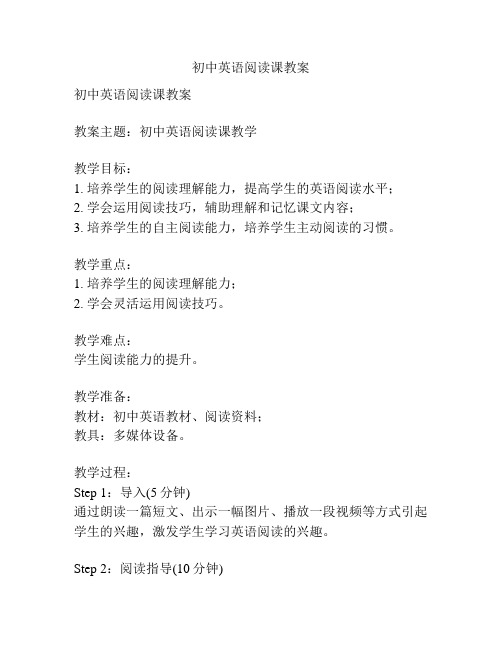
初中英语阅读课教案初中英语阅读课教案教案主题:初中英语阅读课教学教学目标:1. 培养学生的阅读理解能力,提高学生的英语阅读水平;2. 学会运用阅读技巧,辅助理解和记忆课文内容;3. 培养学生的自主阅读能力,培养学生主动阅读的习惯。
教学重点:1. 培养学生的阅读理解能力;2. 学会灵活运用阅读技巧。
教学难点:学生阅读能力的提升。
教学准备:教材:初中英语教材、阅读资料;教具:多媒体设备。
教学过程:Step 1:导入(5分钟)通过朗读一篇短文、出示一幅图片、播放一段视频等方式引起学生的兴趣,激发学生学习英语阅读的兴趣。
Step 2:阅读指导(10分钟)1. 引导学生在阅读之前浏览文章,了解文章的主题和结构;2. 教授一些阅读技巧,如查看标题、图表、关键词等,帮助学生预测文章内容,加速阅读进程;3. 提醒学生在阅读过程中要关注文章的中心思想和关键信息。
Step 3:阅读理解(20分钟)1. 让学生按照预习内容的顺序阅读文章,并回答一些基础的理解问题;2. 引导学生逐段理解文章,分析文章的结构和主题;3. 针对不同的文章类型,在阅读过程中教授不同的阅读方法和技巧;4. 可以设置一些提问、填空、选择等形式的阅读理解题目,检查学生对课文的理解程度。
Step 4:课文分析(10分钟)1. 教师带领学生一起分析文章的结构、语法和词汇等,讲解生词和重要句型的用法;2. 引导学生总结一些阅读技巧和方法,并讨论它们的实际应用。
Step 5:拓展任务(10分钟)1. 分组或个人完成与课文主题相关的拓展任务,如写一篇类似的短文、演讲等;2. 学生展示并互评拓展任务成果。
Step 6:作业布置(5分钟)布置与课文相关的阅读作业,要求学生在家继续阅读相关内容,并提出问题或写一篇短文。
Step 7:小结(5分钟)对本节课的教学过程进行总结,回答学生的问题,并鼓励学生继续努力提高英语阅读能力。
教学反思:针对学生的不同水平和阅读需求,教师需要区别对待,采用不同的教学方法和策略,激发学生学习英语阅读的兴趣和动力。
初中英语阅读课教学设计(精选6篇)
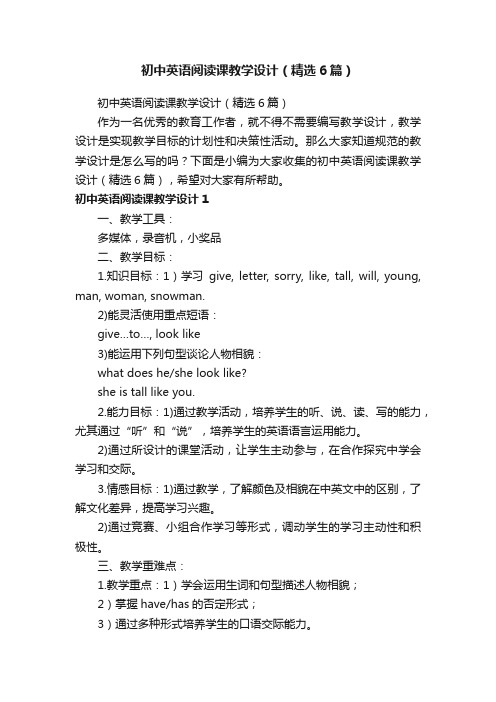
初中英语阅读课教学设计(精选6篇)初中英语阅读课教学设计(精选6篇)作为一名优秀的教育工作者,就不得不需要编写教学设计,教学设计是实现教学目标的计划性和决策性活动。
那么大家知道规范的教学设计是怎么写的吗?下面是小编为大家收集的初中英语阅读课教学设计(精选6篇),希望对大家有所帮助。
初中英语阅读课教学设计1一、教学工具:多媒体,录音机,小奖品二、教学目标:1.知识目标:1)学习give, letter, sorry, like, tall, will, young, man, woman, snowman.2)能灵活使用重点短语:give…to…, look like3)能运用下列句型谈论人物相貌:what does he/she look like?she is tall like you.2.能力目标:1)通过教学活动,培养学生的听、说、读、写的能力,尤其通过“听”和“说”,培养学生的英语语言运用能力。
2)通过所设计的课堂活动,让学生主动参与,在合作探究中学会学习和交际。
3.情感目标:1)通过教学,了解颜色及相貌在中英文中的区别,了解文化差异,提高学习兴趣。
2)通过竞赛、小组合作学习等形式,调动学生的学习主动性和积极性。
三、教学重难点:1.教学重点:1)学会运用生词和句型描述人物相貌;2)掌握have/has的否定形式;3)通过多种形式培养学生的口语交际能力。
2.教学难点:1)have/has的否定形式的教学;2)上课如何调动学生积极性。
四、教学过程step 1 warm up:enjoy a songreview the words about colors.t: we enjoyed a song just now. we have learned some words about color in section a. now please answer my questions.1) what color is it?2) how do you spell it?step 2 presentation1.lead in 3.talk about the colors of some national flags. finish 3.t: what color is the national flag?where is he/she from?what color is his/her hair?what color are his/her eyes?t: do pair works. then ask some pairs to act it out.2. lead in 2.teach “what does he/she look like?”(show another two pictures of women)(teach new words and phrases: look like, tall, man, woman, young.)t: what does the woman look like?ss: she is young. she has short blond hair and a small nose.t: what does the man look like?ss: he is old. he doesn?t have gray hair. his hair is black.(show the four pictures in part 2.)t: turn to page 35, look part 2. match the descriptions with the pictures.(ss match them)t: let?s check the answers.t: do pair works, ask and answer according to the four pictures.3. pair work: talk about the pictures, finish 2.step 3 look, listen and say1.(拿出事先准备好的一个学生的书。
初中英语阅读教案模板

初中英语阅读教案模板一、教学目标1. 知识目标学生能够掌握文章中的关键词汇和短语,理解文章的基本内容。
2. 能力目标学生能够运用阅读策略,如预测、扫描、略读、细读等,提高阅读理解能力。
3. 情感目标学生能够培养对英语阅读的兴趣,增强自信心。
二、教学内容1. 教材:人教版初中英语教材2. 课文:选自人教版初中英语教材的阅读文章三、教学过程1. Pre-reading(课前准备)教师通过引入与文章相关的话题或问题,激发学生的兴趣和好奇心,引导学生预测文章内容。
2. While-reading(阅读过程中)a. Skimming(略读)教师指导学生快速阅读文章,获取文章大意。
b. Scanning(扫描)教师指导学生寻找文章中的特定信息,如人物、地点、时间等。
c. careful reading(细读)教师引导学生仔细阅读文章,理解文章的细节和深层含义。
3. Post-reading(课后活动)a. 复述文章内容教师鼓励学生用自己的话复述文章内容,检查学生对文章的理解程度。
b. 讨论和交流教师引导学生就文章中的话题进行讨论和交流,培养学生的口头表达能力。
四、教学评价1. 课堂参与度观察学生在课堂上的积极参与情况,包括回答问题、参与讨论等。
2. 阅读理解测试通过课后的小测试或作业,评估学生对文章内容的理解程度。
3. 口头表达能力评估学生在讨论和交流中的口头表达能力。
五、教学资源1. 教材:人教版初中英语教材2. 多媒体教学设备:如投影仪、电脑等六、教学时间1课时(40分钟)七、教学建议1. 教师应注重培养学生的阅读兴趣,鼓励学生主动参与课堂活动。
2. 教师应根据学生的实际情况,适当调整教学内容和难度。
3. 教师应注重学生的个体差异,给予每个学生充分的关注和指导。
通过以上教学设计,教师可以有效地进行初中英语阅读教学,提高学生的阅读理解能力和英语综合运用能力。
初中英语阅读课教学步骤
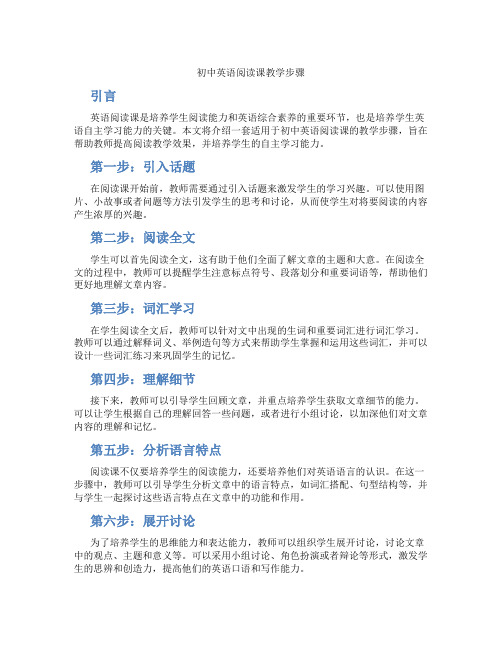
初中英语阅读课教学步骤引言英语阅读课是培养学生阅读能力和英语综合素养的重要环节,也是培养学生英语自主学习能力的关键。
本文将介绍一套适用于初中英语阅读课的教学步骤,旨在帮助教师提高阅读教学效果,并培养学生的自主学习能力。
第一步:引入话题在阅读课开始前,教师需要通过引入话题来激发学生的学习兴趣。
可以使用图片、小故事或者问题等方法引发学生的思考和讨论,从而使学生对将要阅读的内容产生浓厚的兴趣。
第二步:阅读全文学生可以首先阅读全文,这有助于他们全面了解文章的主题和大意。
在阅读全文的过程中,教师可以提醒学生注意标点符号、段落划分和重要词语等,帮助他们更好地理解文章内容。
第三步:词汇学习在学生阅读全文后,教师可以针对文中出现的生词和重要词汇进行词汇学习。
教师可以通过解释词义、举例造句等方式来帮助学生掌握和运用这些词汇,并可以设计一些词汇练习来巩固学生的记忆。
第四步:理解细节接下来,教师可以引导学生回顾文章,并重点培养学生获取文章细节的能力。
可以让学生根据自己的理解回答一些问题,或者进行小组讨论,以加深他们对文章内容的理解和记忆。
第五步:分析语言特点阅读课不仅要培养学生的阅读能力,还要培养他们对英语语言的认识。
在这一步骤中,教师可以引导学生分析文章中的语言特点,如词汇搭配、句型结构等,并与学生一起探讨这些语言特点在文章中的功能和作用。
第六步:展开讨论为了培养学生的思维能力和表达能力,教师可以组织学生展开讨论,讨论文章中的观点、主题和意义等。
可以采用小组讨论、角色扮演或者辩论等形式,激发学生的思辨和创造力,提高他们的英语口语和写作能力。
第七步:总结归纳在阅读课结束前,教师可以帮助学生总结归纳所学内容,重点强调文章的主题和要点。
可以通过提问、填写思维导图等方式来帮助学生理清思路,并检查他们对文章内容的掌握程度。
结语初中英语阅读课教学的目标是培养学生的阅读能力和英语综合素养,通过以上教学步骤可以帮助教师达到这一目标。
初中英语阅读优秀教学教案范文5篇
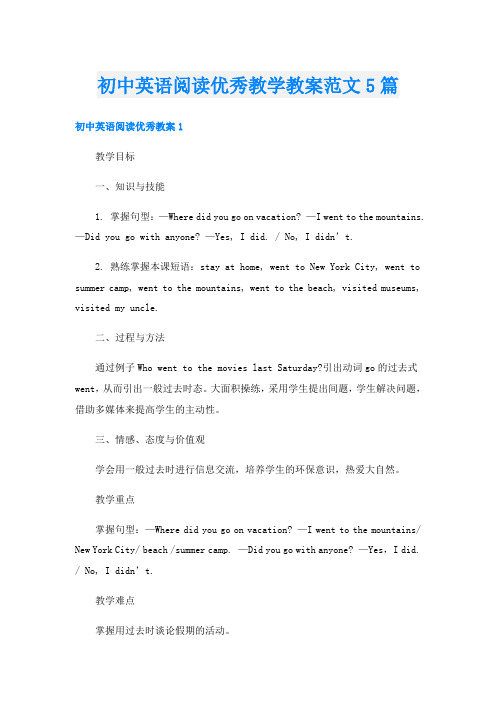
初中英语阅读优秀教学教案范文5篇初中英语阅读优秀教案1教学目标一、知识与技能1. 掌握句型:—Where did you go on vacation? —I went to the mountains. —Did you go with anyone? —Yes, I did. / No, I didn’t.2. 熟练掌握本课短语:stay at home, went to New York City, went to summer camp, went to the mountains, went to the beach, visited museums, visited my uncle.二、过程与方法通过例子Who went to the movies last Saturday?引出动词go的过去式went,从而引出一般过去时态。
大面积操练,采用学生提出间题,学生解决问题,借助多媒体来提高学生的主动性。
三、情感、态度与价值观学会用一般过去时进行信息交流,培养学生的环保意识,热爱大自然。
教学重点掌握句型:—Where did you go on vacation? —I went to the mountains/ New York City/ beach /summer camp. —Did you go with anyone? —Yes,I did. / No, I didn’t.教学难点掌握用过去时谈论假期的活动。
教法导航通过看图、看视频、听录音、问答、讨论等方法学习谈论能力和表达愿望。
学法导航通过看、听、说等各种途径,以小组合作的形式,主动探求知识,锻炼自主学习能力。
教学准备图片,多媒体。
教学过程Step 1 GreetingsGreet the class.Step 2 Lead inAsk questions about what students did last Saturday.(1)Who went to the movies last Saturday? Point to one student who raises his or her hand. Sara went to the movies last Saturday. Repeat.Write this sentence on the board.Underline the word went.(2)Ask:Who visited a friend last Saturday?Point to one student who raises his or her hand.Carlos visited a friend last Saturday.Repeat. Write this sentence on the board. Underline the word “visited”.Point to the words went and visited in the sentences on the board.Say:We use these words to talk about things that happened in the past. Writethese pairs of words on the board:go–went, visit –visited. Ask: Can you point out the words that talk about the past?This activity introduces the key vocabulary.Step 3 Practice1. Focus attention on the picture.Ask: What can you see?Say: Each picture shows something a person did in the each activity and ask students to repeat: went to the mountains, went to New York City, went to summer camp, visited my uncle,stayed at home, went to the beach, visited museums.2.Point to the numbered list of activities.Say each one again and ask the students to repeat.3.Now, please match each phrase with one of the pictures.Say:Write the letter of each picture next to the name of the activity.Point to the sample answer.4.Check the answers.Step 4 Listening1.Point to the picture on the screen. Say: look at Picture A,Where did Tina go on vacation? Yes,she went to the mountains.Ask:What did the person do in each scene? Say: There are three conversations. Play the recording the first time.2. The people talk about what they did on vacation.Listen to the recording and write numbers of the names in the right boxes in the picture.Please write only 5 numbers. Point out the sample answer next to the picture showing went to the mountain. Play the recording a second time.3.Correct the answers.Step 5 Pair workPoint out the example conversation. Ask two students to read the dialogue to the class. Say the dialogue in the picture with a student,Do a second example to the class. Then say:Now work with a partner, make conversations about the people in the pictures.As they talk,move around the classroom monitoring their work. Offer language or pronunciation support as needed.Step 6 Listening1.2a. Ask: Where did the people go on vacation? And then ask the students to listen carefully and fill in the chart. Play the recording twice and then check the answers.2. Look at the form carefully, ask: Did the people do the following things? Then ask thestudents to listen carefully and check the anwers. Play twice and ask the students to check the answers in pairs and then check the answers together.Step 7 Role playLook at the form again carefully and make role-play conversations among Grace, Kevin and Julie. Ask one or two groups to show the conversation first and then get the students to practice in groups.初中英语阅读优秀教案2教学目标学习打招呼的用语,询问姓名和相互间的问候。
初中英语阅读课教案模板范文

初中英语阅读课教案模板范文
一、教学目标
1.知识目标:通过本节课的学习,学生能够熟练掌握本文的关键词汇
和短语。
2.能力目标:提高学生的阅读理解能力,培养学生的批判性思维和创
新能力。
3.情感目标:培养学生对英语阅读的兴趣,激发学生学习英语的热情。
二、教学重点和难点
•教学重点:学生能够准确理解课文内容,掌握关键词汇和短语。
•教学难点:学生能够通过阅读理解课文内容,培养学生对英语阅读的习惯。
三、教学准备
1.教师准备:具有一定的英语教学经验,熟悉本节课的课文内容。
2.学生准备:提前预习课文,准备学习用书和笔记。
四、教学过程
1.导入:谈论课文主题,激发学生对课文的兴趣。
2.预测:让学生根据课文标题和图片预测文章内容。
3.阅读:学生独立阅读课文,并在阅读后回答相关问题。
4.讨论:小组讨论课文内容,并分享自己的理解。
5.总结:整理学生的讨论内容,总结本节课的重点。
6.巩固:布置相关练习,巩固本节课的词汇和短语。
五、教学反思
本节课通过多种教学方法,旨在提高学生的阅读理解能力,并培养学生对英语
阅读的兴趣。
学生积极参与,表现出良好的学习状态。
下节课将继续巩固学生的阅读能力,拓展学生的词汇量,提高学生的综合英语能力。
以上是本节课的教案范文,希望对您有所帮助。
初中英语阅读教学步骤

初中英语阅读教学步骤初中英语阅读教学步骤英语初中新教材,内容活泼,生动有趣,形式多样,口语性强,多以对话表演形式出现,注重培养学生的语言交际能力,多数课文设有简单情景,图文并茂,语法寓于情景之中,形象直观符合中学生年龄特征。
下面是店铺整理的初中英语阅读教学步骤,欢迎来参考!如果在教学中我们的每一节课都能够完美地落实好课堂教学步骤,就能得到课堂整体效益的最佳设计,就能在课堂教学中确立学生的主体地位,还课堂于学生。
实践证明,掌握新教材的特点,依据教学大纲,采取五步教学法,即Revision、Presentation(呈现)、Drill (操练)、Practice、Consolidation(巩固),充分体现教师的主导作用和学生的主体作用,有助于教学活动的开展,有助于提高学生运用语言的能力。
一、复习复习在每节课前开始,教师是“强化记忆者”,可以采取多种形式,对前面几节课的内容进行检查复习,以求巩固和掌握已学知识,如连珠炮似的提问,要求学生迅速应答,也可以进行连锁操作,即学生间互相提问,这样不仅温习了旧知识,也培养了学生的应变能力和用英语进行交际的能力。
复习时可以使知识再现,是巩固所学的知识不可缺少的一个重要环节。
《课标》是中考命题,备考复习的重要依据,随着课程改革的不断深入,中考命题已由知识立意转变为能力立意。
从近年来中考来看,都是从“知识与技能、过程与方法、情感态度与价值观”等方面,对学生应掌握的内容和应具备的能力进行全面考核。
只有从《课标》出发,回归教材才可以紧扣要点。
《课标》明确了对考生所学语言知识的要求,列出了语言运用能力中听、说、读、写四种技能的具体要求,对英语总复习起着导向作用,《考试说明》则明确了中考要求的词汇、语法、句法、中考题型和具体考点,并附有经典的套题,包括阅读理解、完型填空等。
二、呈现特定情景,引出句型,交换情景,操练句型。
此时教师扮演者“示范表演者”,通过幻灯片或者电视录像,展示情景,用较为易懂的英语讲诉课文内容和有关作者情况,讲诉时,以视听为突破口,声情并茂,使学生有身临其境的感觉,同时创造一种轻松愉快、活泼的气氛,消除学生的心理障碍,从而达到良好的教学效果。
初中英语阅读课教案

初中英语阅读课教案
一、教学目标
1. 培养学生阅读英语的兴趣和能力。
2. 提高学生的英语语感和理解能力。
3. 帮助学生掌握一些阅读技巧和策略。
二、教学内容
1. 选择一些适合初中生阅读的英语文章。
2. 着重讲解文章中的重点词汇和句子。
3. 引导学生进行文本理解和推理等阅读能力的训练。
三、教学步骤
1. 激发学生的阅读兴趣:通过介绍有趣的英语故事或文章,引起学生的阅读兴趣。
2. 讲解文章内容:详细解读文章的主要内容,帮助学生理解文章的意思。
3. 练重点词汇和句子:通过课堂练和小组活动,帮助学生掌握文章中的重点词汇和句子。
4. 进行阅读理解练:设计一些与文章相关的问题,让学生运用阅读技巧进行理解和回答。
5. 分享阅读心得:鼓励学生分享自己的阅读感受和体会,并进行讨论。
四、教学评估
1. 给学生提供一篇新的文章进行阅读,并设计相应的问题考察学生的阅读理解能力。
2. 观察学生在课堂上的表现,包括参与度、理解能力和合作能力。
五、教学资源
1. 选择合适的英语阅读教材和练题。
2. 准备一些有趣的英语短故事或文章。
3. 准备一些课堂练和小组活动的材料。
六、教学扩展
1. 鼓励学生多读英语文章,提高阅读能力。
2. 帮助学生构建英语词汇量,扩充阅读范围。
3. 提供更多的阅读技巧和策略,帮助学生更好地理解和运用所读的英语文章。
以上是初中英语阅读课教案的内容,希望能对教学有所帮助。
初中英语阅读原创教案
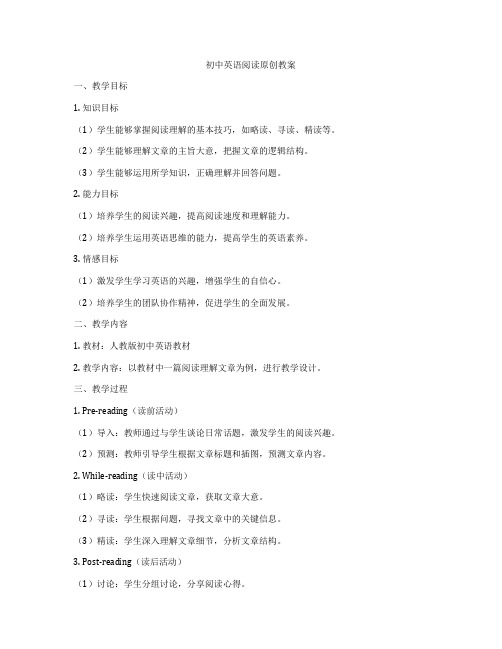
初中英语阅读原创教案一、教学目标1. 知识目标(1)学生能够掌握阅读理解的基本技巧,如略读、寻读、精读等。
(2)学生能够理解文章的主旨大意,把握文章的逻辑结构。
(3)学生能够运用所学知识,正确理解并回答问题。
2. 能力目标(1)培养学生的阅读兴趣,提高阅读速度和理解能力。
(2)培养学生运用英语思维的能力,提高学生的英语素养。
3. 情感目标(1)激发学生学习英语的兴趣,增强学生的自信心。
(2)培养学生的团队协作精神,促进学生的全面发展。
二、教学内容1. 教材:人教版初中英语教材2. 教学内容:以教材中一篇阅读理解文章为例,进行教学设计。
三、教学过程1. Pre-reading(读前活动)(1)导入:教师通过与学生谈论日常话题,激发学生的阅读兴趣。
(2)预测:教师引导学生根据文章标题和插图,预测文章内容。
2. While-reading(读中活动)(1)略读:学生快速阅读文章,获取文章大意。
(2)寻读:学生根据问题,寻找文章中的关键信息。
(3)精读:学生深入理解文章细节,分析文章结构。
3. Post-reading(读后活动)(1)讨论:学生分组讨论,分享阅读心得。
(2)回答问题:学生根据文章内容,回答问题。
(3)总结:教师引导学生总结文章主旨,巩固所学知识。
四、教学评价1. 过程评价:观察学生在阅读过程中的态度、行为、合作情况等,评价学生的阅读能力。
2. 结果评价:通过回答问题、完成练习等,评价学生对文章内容的理解程度。
3. 自我评价:学生对自己在阅读过程中的表现进行评价,反思自己的学习方法。
五、教学反思教师在课后要对阅读教学进行反思,分析教学过程中的优点和不足,不断调整教学方法,提高学生的阅读理解能力。
六、教学拓展1. 推荐阅读:教师为学生推荐与文章主题相关的阅读材料,提高学生的阅读量。
2. 课外活动:组织英语角、英语剧社等活动,让学生在实践中提高英语素养。
3. 家庭作业:布置适量阅读作业,巩固课堂所学知识。
初中英语教案阅读课王蔷

初中英语教案阅读课王蔷教案标题:初中英语阅读课教案——王蔷教案目标:通过阅读课的教学,使学生能够:1. 提高对英语阅读材料的理解能力;2. 掌握阅读技巧,如推理、推断、解释等;3. 培养学生的阅读兴趣和自主学习能力;4. 了解和学习王蔷的成功故事。
教学重点:1. 学习并理解阅读材料中的关键信息;2. 学习阅读技巧,并能运用到实际阅读中;3. 通过阅读王蔷的成功故事,激发学生的进取心和学习动力。
教学准备:1. 王蔷的成功故事相关阅读材料;2. 学生课本及练习册;3. 多媒体设备。
教学过程:步骤一:导入(5分钟)1. 呈现一张王蔷的照片,让学生观察并描述她的特点;2. 引导学生回顾和讨论一下王蔷是谁,有什么成就和贡献。
步骤二:阅读前准备(10分钟)1. 教师简要介绍阅读材料的主题和内容,激发学生的学习兴趣;2. 提出几个问题,让学生思考并预测阅读材料的可能内容。
步骤三:阅读理解(15分钟)1. 学生独立阅读相关材料,并标记出关键信息;2. 学生在小组内交流阅读理解,并解答老师提出的问题;3. 教师引导学生讨论并思考某些问题的答案。
步骤四:阅读技巧讲解(10分钟)1. 教师介绍一些提高阅读理解能力的技巧,如推理、推断、解释等;2. 引导学生运用这些技巧来理解和解释阅读材料。
步骤五:小组活动(15分钟)1. 将学生分成小组,每组就一段阅读材料展开讨论和研究;2. 学生彼此交流各自的理解和分析,并互相提出问题。
步骤六:课堂讨论(10分钟)1. 学生展示他们小组的研究成果,分享对阅读材料的理解和思考;2. 教师带领全班讨论,解答学生可能存在的疑问。
步骤七:延伸拓展(10分钟)1. 学生自主阅读其他与王蔷相关的材料,并写下自己的阅读心得;2. 学生分享各自的心得和感受,并进行展示。
步骤八:课堂总结(5分钟)1. 教师总结本节课的学习内容和重点;2. 鼓励学生在以后的阅读学习中多运用阅读技巧,提高阅读能力。
教学反思:本节课通过引入王蔷的成功故事,激发了学生的学习动力和兴趣。
传统的初中英语阅读课教学流程
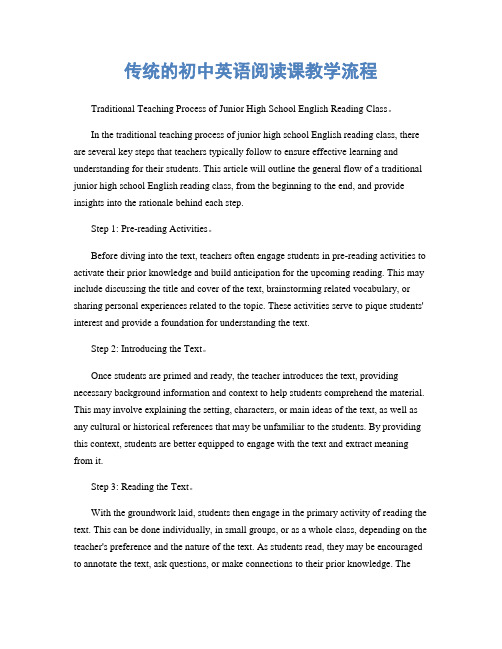
传统的初中英语阅读课教学流程Traditional Teaching Process of Junior High School English Reading Class。
In the traditional teaching process of junior high school English reading class, there are several key steps that teachers typically follow to ensure effective learning and understanding for their students. This article will outline the general flow of a traditional junior high school English reading class, from the beginning to the end, and provide insights into the rationale behind each step.Step 1: Pre-reading Activities。
Before diving into the text, teachers often engage students in pre-reading activities to activate their prior knowledge and build anticipation for the upcoming reading. This may include discussing the title and cover of the text, brainstorming related vocabulary, or sharing personal experiences related to the topic. These activities serve to pique students' interest and provide a foundation for understanding the text.Step 2: Introducing the Text。
英语初中阅读课的上课流程

初中英语阅读课的教学流程探索English reading classes in junior high school aim to develop students' comprehension, vocabulary, and language skills through exposure to a variety of texts. A typical lesson follows a structured yet dynamic approach that encourages active participation and critical thinking.Here's an exploration of the teaching process for English reading classes in junior high schools.**Pre-Reading Activities*** **Interest Activation**: The teacher begins by activating students' interest by discussing topics relatedto the reading material. This can be done through questions, discussions, or even short videos or images that pique curiosity. * **Vocabulary Preview**: New vocabulary words from the reading are introduced. The teacher might use context clues, pictures, or definitions to help students understand the meaning of these words.**While-Reading Activities*** **Skimming and Scanning**: Students are taught toskim the text quickly to get a general idea of the content.Then, they scan for specific information to answer questions or find key details. * **Comprehension Questions**: The teacher poses questions about the reading material to check students' understanding. These questions range from factual to inferential, encouraging deeper thinking. * **Group Discussions**: Students are divided into groups and asked to discuss certain aspects of the text. This promotes collaborative learning and enhances understanding through peer interaction.**Post-Reading Activities*** **Summary and Retelling**: Students are asked to summarize the main ideas of the text or even retell the story in their own words. This helps consolidate their understanding. * **Vocabulary Application**: Students use the new vocabulary words in sentences or paragraphs of their own, applying their knowledge in a creative way. * **Critical Thinking**: The teacher encourages students to ask questions, evaluate the text critically, or even compare and contrast it with other readings.**Homework or Extension Activities*** **Related Reading**: Students are often assigned readings that are related to the theme or genre of the class reading, allowing them to expand their knowledge and skills. * **Writing Assignments**: They might be asked to write a review, a reflection, or an essay based on the reading, fostering critical thinking and writing skills.In conclusion, the teaching process for English reading classes in junior high schools is a blend of pre-reading, while-reading, and post-reading activities designed to engage students actively and develop their reading comprehension, vocabulary, and critical thinking skills. The dynamic nature of these lessons ensures that students not only learn but also enjoy the process of reading and discovering new knowledge.**初中英语阅读课的教学流程探索**初中英语阅读课旨在通过让学生接触各种文本,培养他们的理解能力、词汇量和语言技能。
- 1、下载文档前请自行甄别文档内容的完整性,平台不提供额外的编辑、内容补充、找答案等附加服务。
- 2、"仅部分预览"的文档,不可在线预览部分如存在完整性等问题,可反馈申请退款(可完整预览的文档不适用该条件!)。
- 3、如文档侵犯您的权益,请联系客服反馈,我们会尽快为您处理(人工客服工作时间:9:00-18:30)。
初中英语阅读课教学流程与教学课例会昌实验学校王久荣一、教学流程与操作要求(一)、预习检查课前下发预习任务,主要是翻译词组与句子。
其中不包括全部生词,让学生在阅读过程中还有猜测环节。
(二)、课前热身设计与阅读内容相关的情境性活动,注意生词的复现,从而巩固生词。
主要采取小组活动,这样既巩固了词汇,同时也为阅读做了铺垫。
(三)、任务阅读1、读前活动(Pre-reading activities)学生可根据标题或课本中的插图猜测课文内容;教师可根据阅读材料设计判断正误题(T\F),让学生先判断再速读课文检查。
2、阅读活动(While- reading activities)(1)、速读(Fast reading)教师设计简单的任务。
如What’s the article about? Who is Lucky? 或提供每段的小标题,让学生通过选择的形式放在正确的段落。
还可设计简单的T\F问题。
引导学生通过跳读(获取特定信息的阅读)快速完成任务,从而整体理解文章大意。
(2)、细读(Careful reading)任务设计:回答问题、选择题、填表、T\F问题等;文字字面理解任务。
包括学生找出重点词组句子,讨论理解。
对于难以理解的知识点在导学案中体现。
如:Being blind, deaf, unable to walk, or use your hands easily is something t hat most people cannot imagine. 此句中“being…”是动名词做主语。
谓语动词用单数。
“…that most people cannot imagine”是定语从句,修饰something。
3、课后活动(Post reading activities)(1)、对文章观点及问题的讨论、复述、分角色表演,完成所写文章等。
(2)、学生的总结(小组合作):学习所得,语言知识等。
(3)、拓展阅读:老师可选择一篇或几篇相关内容的文章,设计任务,学生带任务阅读。
这是对阅读技巧及语言知识的巩固性检查。
(四)、拓展写作根据本课的阅读课文,可采用不同的形式:如仿写、提示性写作、变式写作等。
(五)、展示交流给学生展示和交流的时间和舞台,让每组学生展示自己的观点、方法、成果,自由的与老师、同学进行交流。
(六)、归纳总结通过进行一系列的活动,让学生进行总结,形成一定的学习策略。
(七)、达标检测针对学习内容,进行及时的练习,从而达到学以致用,扎实落实教学目标。
Unit 7 I’ll send you a photo of lucky. 阅读课导学案案例【学习目标】:1、知识目标:理解掌握课本中出现的重点词句。
2、能力目标:掌握阅读和写作技巧。
3、情感目标:A:学生积极参加与他人合作和交流,培养合作精神。
B:通过阅读文章,让学生学会遇到问题时的处理方法,并学会勇敢面对生活。
【教学重难点】教学重点:理解掌握clean up, hunger, homeless, cheer up, give out, volunteer, bank教学重难点:掌握阅读技巧,获取信息:理解掌握词组。
一自主先学(一)试翻译下列短语.1. 立即,马上___________2. 帮助某人解决困难______________3.不能做某事_____________4. 使某人高兴起来____________5. 我将寄给你一张Lucky的照片。
____________________________________6. 我很感谢你资助“动物助手”。
_______________________________________二.学习过程:1、检查预习情况。
2、PresentationLook at the screen. Show some pictures and teach the new words: disabled blind deaf donation appreciated unable.3、任务阅读(1)、Fast readingRead this letter quickly, then answer these questions.1. Is the article a letter or o note?2. What’s the article about?3. Who is Lucky?4. What’s wrong with Liz?(2)、Careful readingTask 1Read paragraph 1 carefully, then answer these questions.1. What is “Animal Helpers”?2.What has Lucky done?Task 2Read paragraph 2 carefully, then fill in the blanks.Being _____, ______, ______ to walk or use your hands easily is something that most people _______ ________. But there are many people who face the se ________, and I am one of them. Because I can't use my arms or legs wel l, normal things like ________the telephone, opening and ______ doors or ___ ___things have always _____difficult for me. Then one day last year, a friend of ____said that she would like to ____ me_____. She said she _____ talk to “_____ ______ " to see if it would be _______ for me to get a ________tra ined dog. She also thought a dog might ______ me_____. I told her that I lo ve animals and that I'd love to have a dog.Task 3Read the last three paragraphs, then write down T or F .1. After six weeks of training with a dog at “AnimalHelpers”, Liz was able to bring him home. ( )2. Lucky is an amazing cat. ( )3. It ’s very important that this organization runs outof money. ( )4. Lucky is clever and even understands somedi fficult words like “upstairs ”. ( )(3)、Post reading1. Use information in the letter to make true sentences by matching the differe3.Summary: Let the students do it.·点拨交流1.I’d like to thank you for sending money to“Animal Helpers”, an organization set up to help disabled people.“Animal Helpers”动物助手,一个帮助残疾人而建立的组织。
Thank sb. for …为……而感谢某人e.g._______ _____ for your flowers to me。
谢谢你送的花。
set up…引导的是一个省去关系代词that的定语从句。
e.g. Thomas has a lab ______ _____ _________.汤姆有一个他自己建的实验室2. Being blind, deaf, unable to walk, or use your hands easily is something th at most people cannot imagine.此句中“being…”是动名词做主语。
谓语动词用单数。
“…that most people cann ot imagine”是定语从句,,修饰something。
3. Then one day last year, a friend of mine said that she would like to help me out.Help out 意为“使某人脱离困境”可分开使用。
e.g. Nobody ______ me ______when I lost my job.当我丢失工作时,没有一个人帮助我。
4. You see, I’m only able to have a “dog-helper” because of your kind donati on!此句中的be able to 意为“能够做……的事”, 可用can替换,主语为物时一般都使用can, can没有将来时和完成时, 也不能用于其他助动词后面, 所以常用be a ble to do 来替换。
Because of 是介词短语, 表原因, 后面接名词或代词宾语。
because 是连词, 词后常接从句。
e.g. (1) 昨天他没有到校是因为他病了。
He didn’t come to school yesterday _______ he was ______.(2)由于下雨,运动会被推迟了。
The sports meeting has been put off ____ ____ the rain.(三)、拓展写作Write a short reply to Liz Smith. In your letter:1.Offer to help her more.2.Say why you are able to help.3.Say what you could do to help.Dear Liz,_____________________________________________________________________________________________________________________________ _____________________________________________________________________ _____________________________________________________________________ _____________________________________________________________________ ___________________________________________________________ (四)、展示交流给学生展示和交流的时间和舞台,让每组学生展示自己的观点、方法、成果,充分与老师、同学进行交流。
